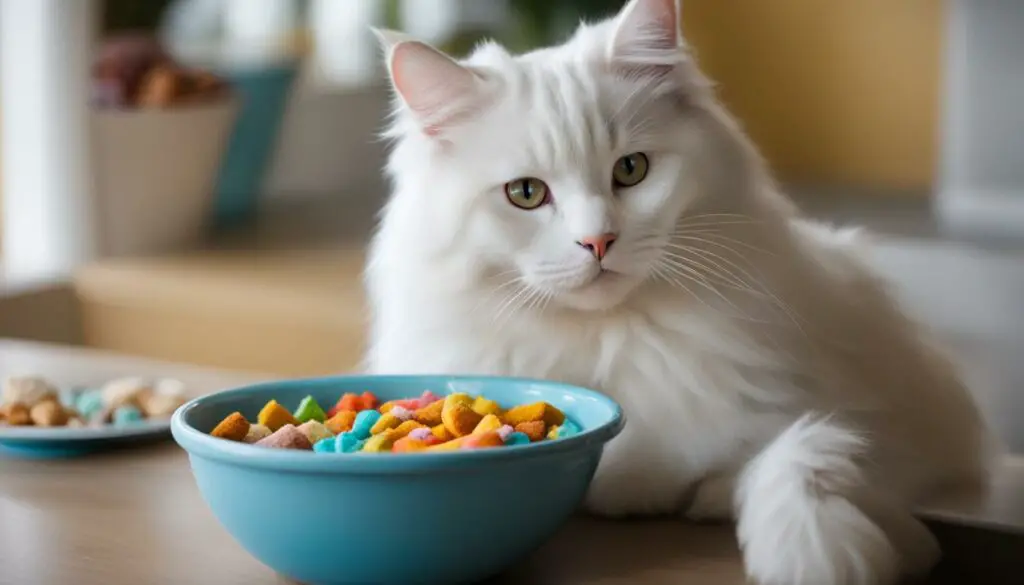Hello, cat owners! Have you ever wondered why your furry friend doesn’t show any interest in treats? It can be quite puzzling when your cat refuses to eat treats that other cats gobble up eagerly. But fret not, because I’m here to help you understand why your cat behaves this way and provide you with some solutions and tips to overcome this challenge.
Cats, like any animal, are programmed for survival. They have natural instincts and motivators that guide their behavior. Food is one of these motivators, but not all cats are equally food motivated. Some cats simply don’t find treats appealing or enjoyable, and that’s perfectly normal.
There could be several reasons why your cat doesn’t like treats. One possibility is that they are already satisfied with their regular meals and don’t feel the need for extra calories. Another reason could be that the treats you’re offering don’t match their taste preferences. Cats are known for their selective nature, and what may be enticing to one cat may not appeal to another.
In some cases, a cat’s disinterest in treats could be a sign of an underlying health issue. If your cat is generally lethargic or uninterested in food altogether, it’s important to consult with a veterinarian to rule out any medical conditions that may be affecting their appetite.
But don’t worry, there are steps you can take to address this issue and train your cat effectively, even if they’re not food motivated. By understanding their preferences, making dietary adjustments, and using alternative rewards, you can still achieve successful training sessions and strengthen the bond with your feline companion.
Key Takeaways:
- Not all cats are equally food motivated, and some may not like treats.
- Some reasons why cats may not like treats include already being satisfied with regular meals or not liking the specific type of treat being offered.
- If your cat is acting lethargic or uninterested in food overall, it’s important to consult a veterinarian to rule out any underlying health issues.
- Switching from free-feeding to scheduled meals and offering wet or raw food can increase your cat’s food motivation.
- To train a cat that’s not food motivated, consider using alternative rewards such as toys or catnip.
Why is My Cat Picky With Treats?
While treats are often a popular choice for rewarding and training cats, some feline friends can be quite picky when it comes to their treats. Understanding why your cat is selective with treats can help you find the right solutions to address their preferences and ensure successful training sessions.
One possible reason for your cat’s pickiness is that they are already consuming enough food and don’t need the extra calories from treats. Cats have specific dietary requirements, and if their nutritional needs are already being met, they may not show interest in treats. Additionally, individual cats have unique preferences when it comes to taste and texture, so the specific type of treat being offered may not align with their preferences.
If your cat appears overall uninterested or lethargic when it comes to food, it’s essential to consider the possibility of an underlying health issue. Cats can be masters at hiding their discomfort, and a lack of appetite or disinterest in treats could be a sign that something is amiss. Consulting with a veterinarian can help rule out any medical conditions and ensure your cat’s well-being.
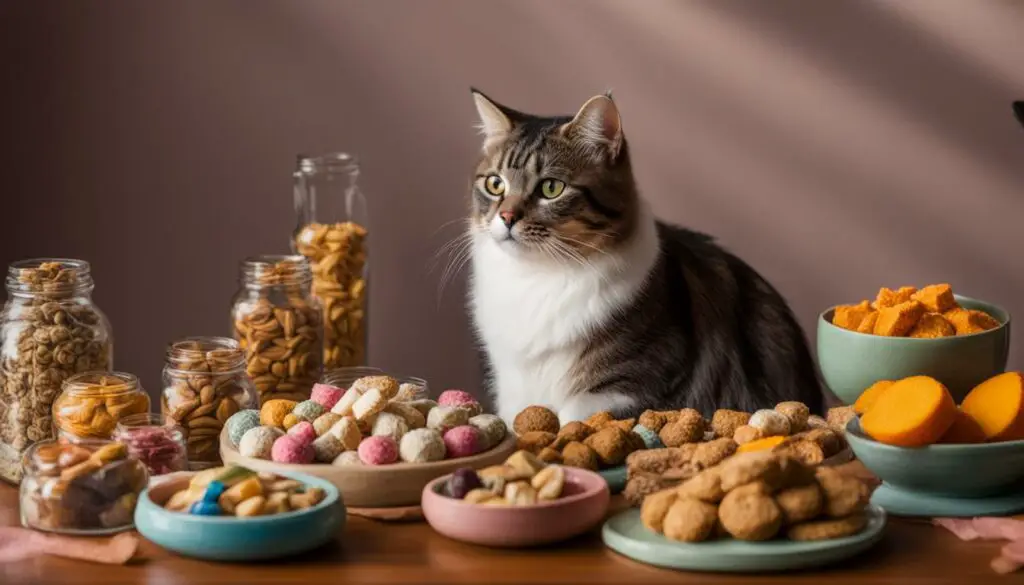
Why is My Cat Picky With Treats?
| Reasons for Cat’s Picky Behavior | Solutions |
|---|---|
| Your cat is already consuming enough food and doesn’t need the extra calories from treats. | Ensure your cat’s nutritional needs are being met through their regular meals and adjust the portion sizes accordingly. |
| Your cat has specific preferences when it comes to taste and texture. | Experiment with different types of treats to find the ones that your cat finds most appealing. |
| Your cat’s pickiness may be a sign of an underlying health issue. | Consult with a veterinarian to rule out any medical conditions and ensure your cat’s overall health. |
By understanding the reasons behind your cat’s picky behavior and implementing suitable solutions, you can create a positive and rewarding training experience for both you and your feline companion. Remember to be patient and adaptable, tailoring your approach to meet your cat’s individual needs and preferences.
How to Increase Your Cat’s Food Motivation
If your cat isn’t food motivated, there are steps you can take to increase their interest in treats. One option is to switch from free-feeding to scheduled meals, which allows you to control when your cat is eating and increase their appetite for training rewards. Another option is to switch to a wet or raw diet, which can be more appealing to cats and increase the value of treats. It’s also important to stop creating negative associations with treats by using counterconditioning techniques to create positive experiences.
Counterconditioning involves pairing treats with positive stimuli to change your cat’s perception of treats. For example, if your cat has had a negative experience with treats in the past, you can start by associating treats with something your cat enjoys, like playtime or petting. Gradually, your cat will begin to associate treats with positive experiences and become more motivated to engage with them.
- Switch from free-feeding to scheduled meals
- Consider a wet or raw diet
- Use counterconditioning techniques to create positive associations with treats
By implementing these strategies, you can help increase your cat’s food motivation and boost their appetite for treats. Remember to be patient and consistent in your training efforts, as each cat is unique and may require different approaches. Consult with a veterinarian or professional cat trainer for additional guidance tailored to your cat’s individual needs.
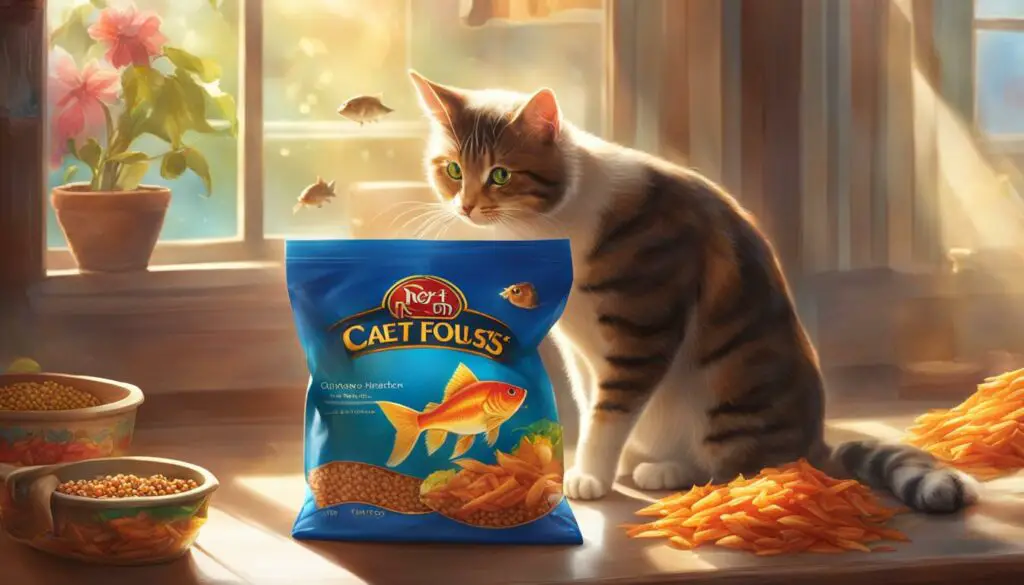
| Tips to Increase Your Cat’s Food Motivation | Benefits |
|---|---|
| Switch from free-feeding to scheduled meals | Allows you to control when your cat is eating and increases their appetite for training rewards |
| Consider a wet or raw diet | Can be more appealing to cats and increase the value of treats |
| Use counterconditioning techniques | Creates positive associations with treats, increasing motivation |
Choosing the Right Treats for Your Cat
When it comes to selecting treats for your cat, it’s important to consider their preferences and nutritional needs. Cats, like humans, have individual tastes and dietary requirements, so finding the right treats can take some trial and error. Here are some factors to consider when choosing cat treats:
- Type of Treat: There are various types of treats available for cats, including crunchy treats, soft treats, flavored treats, and wet food. Each type offers a different texture and taste, so it’s important to observe your cat’s preference and choose accordingly. Some cats may prefer the crunchiness of dry treats, while others may enjoy the moistness of wet treats.
- Ingredients: Reading the ingredients list is crucial to ensure the treats are of high quality and suitable for your cat. Avoid treats that contain artificial flavors, colors, or excessive amounts of sugar. Look for treats made with real meat or fish as the main ingredient, as these are more likely to be appealing to your cat.
- Health Considerations: Consider any health concerns or dietary restrictions your cat may have. For example, if your cat has allergies or a sensitive stomach, opt for treats that are specifically formulated for those conditions. Additionally, consult with your veterinarian to determine if there are any ingredients you should avoid.
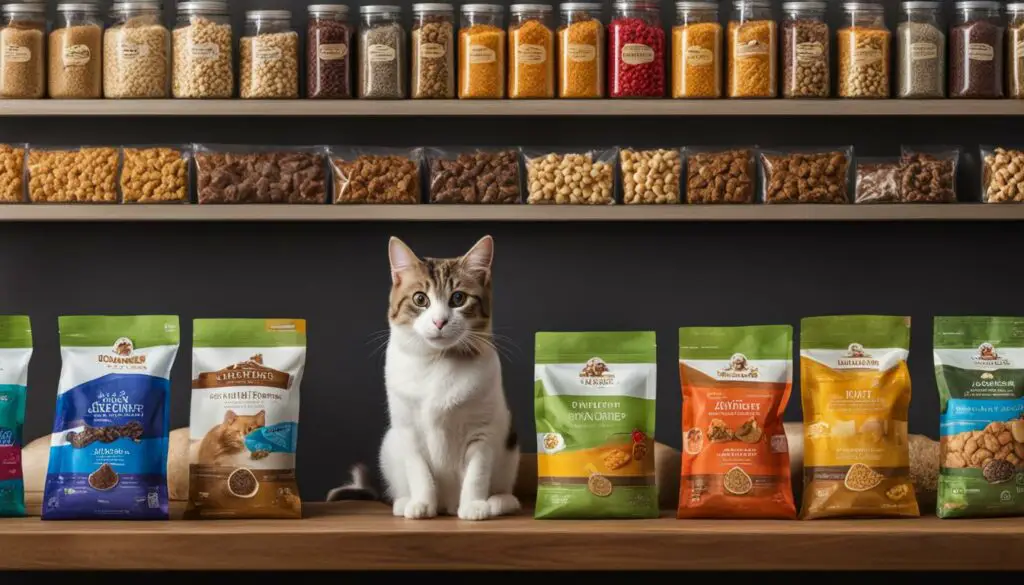
“The right treats can provide a source of enrichment for your cat and strengthen the bond between you. By considering your cat’s preferences and nutritional needs, you can choose treats that not only taste good but also contribute to their overall well-being.”
Remember that treats should be given in moderation and not make up a significant portion of your cat’s daily caloric intake. It’s important to strike a balance between rewarding your cat and maintaining a healthy diet. If you have any concerns about your cat’s treat consumption or dietary needs, consult with your veterinarian for guidance.
| Treat Type | Texture | Taste | Key Features |
|---|---|---|---|
| Crunchy Treats | Hard and crunchy | Varying flavors | Can help clean teeth |
| Soft Treats | Soft and chewy | Meat or fish flavors | Easier to chew and digest |
| Flavored Treats | Varies (crunchy or soft) | Unique flavors (e.g., salmon, catnip) | Appealing to cats with specific preferences |
| Wet Food Treats | Moist and tender | Real meat or fish flavors | Can be used as a special treat or meal topper |
Table: Types of Cat Treats and their Characteristics
Tips for Training a Cat That’s Not Food Motivated
Training a cat that doesn’t like treats can be a challenge, but with the right strategies, it’s possible to achieve success. Here are some tips to help you train your cat, even if they’re not motivated by food:
1. Find Alternative Rewards
If your cat isn’t interested in treats, try using other rewards that they find appealing. Toys, playtime, or attention can be excellent motivators for many cats. Experiment with different types of rewards to find what gets your cat excited and engaged during training sessions.
2. Break Treats into Smaller Pieces
If your cat does show some interest in treats, but quickly loses motivation, try breaking the treats into smaller pieces. This way, you can offer more rewards during a training session, keeping your cat engaged for longer periods. This can help maintain their focus and increase their overall motivation.
| Tips for Training a Cat That’s Not Food Motivated | |
|---|---|
| Find alternative rewards | Experiment with toys, playtime, or attention as motivators |
| Break treats into smaller pieces | Offer more rewards during training sessions to maintain motivation |
| Use clicker training paired with play or attention rewards | Combine clicker training with other positive reinforcement techniques |
3. Combine Clicker Training with Other Rewards
Clicker training can be a powerful tool for cat training, even if they don’t respond to treats. Pair the clicker with playtime or attention rewards to reinforce desired behaviors. For example, if your cat performs a desired behavior during training, immediately follow it with playtime or petting to create a positive association.
Remember, every cat is unique, so it may take some time and experimentation to find the right training approach for your feline friend. Be patient, stay consistent, and celebrate small successes along the way. With perseverance and the right rewards, you can successfully train a cat that’s not food motivated.
The Importance of Controlling Treat Intake
When it comes to treating our cats, it’s important to strike a balance between reward and overindulgence. Controlling your cat’s treat intake is crucial in maintaining their overall health and preventing potential issues that can arise from overfeeding. By monitoring and regulating the amount of treats your cat consumes, you can ensure they maintain a healthy weight and avoid unnecessary health risks.
Overfeeding treats can lead to obesity, which can have detrimental effects on your cat’s well-being. It can contribute to various health problems such as diabetes, joint issues, and heart disease. As loving cat owners, it is our responsibility to provide our feline friends with a well-balanced diet that meets their nutritional needs. While treats can be an enjoyable addition to their diet, they should not make up a significant portion of their daily caloric intake.
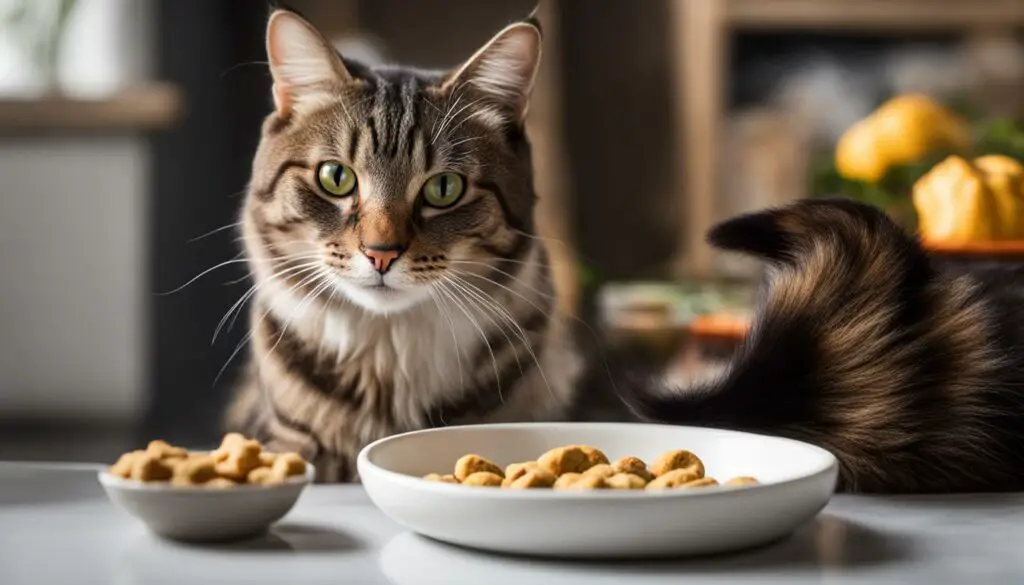
To avoid overfeeding treats, it’s essential to establish proper portion control. Consult with your veterinarian to determine the appropriate number of treats your cat should receive each day based on their age, weight, and overall health. This will help you create a treat regimen that aligns with your cat’s dietary requirements and prevents excessive consumption.
Additionally, it’s important to choose treats that are low in calories and made with quality ingredients. Look for treats that are specifically formulated for cats, as they are designed to provide the right balance of nutrients without unnecessary additives. Reading the labels and understanding the ingredients will ensure that you are making informed decisions about the treats you give your cat.
| Tips for Controlling Treat Intake: |
|---|
| 1. Set a daily limit: Determine the number of treats your cat can have each day and stick to it. |
| 2. Measure the portions: Use a measuring cup or scale to ensure you are providing the correct amount of treats. |
| 3. Opt for healthier alternatives: Choose treats that are low in calories and made with nutritious ingredients. |
| 4. Use treats as occasional rewards: Instead of offering treats constantly, reserve them for training sessions or as special rewards for good behavior. |
| 5. Monitor your cat’s weight: Regularly check your cat’s weight to ensure they are maintaining a healthy body condition. If you notice any significant changes, consult with your veterinarian. |
By controlling your cat’s treat intake, you can promote their overall health and well-being. Remember, treats should be seen as occasional rewards rather than a staple in their diet. Prioritize your cat’s nutritional needs and provide them with a balanced diet that includes high-quality food and the right amount of treats to keep them happy and healthy!
Using Rewards Other Than Treats
If your cat doesn’t respond to treats or simply doesn’t enjoy them, there are alternative rewards you can use to reinforce positive behavior. Toys can be a great option for rewarding your cat. Interactive toys that require your cat to play and engage can be both mentally and physically stimulating. You can use toys such as puzzle toys, feather wands, or laser pointers to encourage your cat to play and reward them for good behavior.
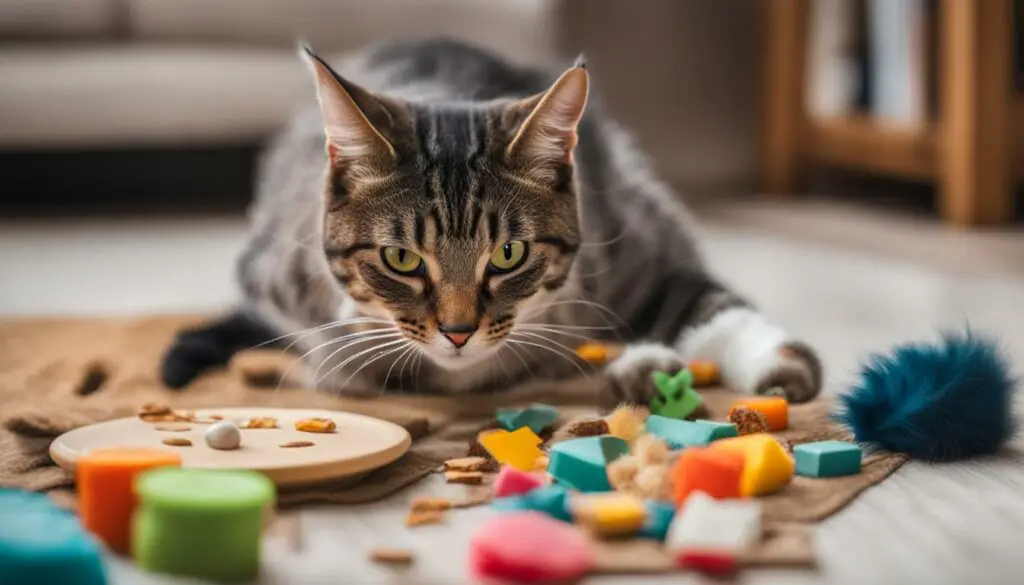
Another alternative reward for your cat is catnip. Many cats are attracted to the scent of catnip, which can stimulate their playfulness and provide a positive experience. You can use catnip as a reward by sprinkling it on toys, scratching posts, or in a designated play area. It’s important to note that not all cats are affected by catnip, so if your cat doesn’t respond to it, try other alternatives such as silvervine or valerian root.
When using toys or catnip as rewards, it’s crucial to associate them with positive behavior and make them a part of your training routine. This will help your cat understand that engaging in desirable behaviors will result in fun and rewarding experiences. Consistency and repetition are key to reinforcing these positive associations.
Table: Alternatives to Cat Treats
| Reward | Description |
|---|---|
| Toys | Interactive toys that engage your cat in play and mental stimulation. |
| Catnip | A herb that can stimulate playfulness and provide a positive experience for cats. |
| Silvervine | An alternative to catnip that can attract and stimulate cats. |
| Valerian Root | Another alternative to catnip with calming and stimulating effects on cats. |
Remember, every cat is unique, and it may take some time to find the right alternative reward that motivates your cat. Pay attention to your cat’s preferences and adjust your training approach accordingly. By using toys or catnip as rewards, you can create a positive training experience and strengthen the bond between you and your feline companion.
Incorporating Treats Into Training
When it comes to training your cat, treats can be a valuable tool. By using treats as rewards for desired behaviors, you can reinforce positive behavior and make the training process more enjoyable for your cat. But how do you effectively incorporate treats into your cat’s training regimen? Here are some tips and strategies to help you get started.
To begin, choose the right type of treat that your cat finds appealing. Whether it’s crunchy treats, soft treats, or even bits of their favorite wet food, finding a treat that your cat loves will increase their motivation during training sessions. Consistency is key, so be sure to use the same type of treat consistently to reinforce the desired behavior.
Timing is also crucial when using treats as training rewards. Immediately reward your cat with a treat when they exhibit the desired behavior. This helps them make the connection between the behavior and the reward. Clicker training can be a useful technique to pair the sound of the clicker with the treat, signaling to your cat that they have performed the behavior correctly.
| Treats for Training | Benefits |
|---|---|
| Crunchy treats | Great for cats who enjoy a satisfying crunch and can provide dental benefits. |
| Soft treats | Perfect for training cats who prefer a softer texture or have dental sensitivities. |
| Bits of wet food | Ideal for cats who have a particular preference for wet food or are on a wet food diet. |
Remember, while treats are important for training, they should make up only a small portion of your cat’s overall diet. It’s essential to maintain a balanced and nutritionally complete diet for your cat’s overall well-being. Consult with your veterinarian for guidance on the best treats to incorporate into your cat’s training routine.
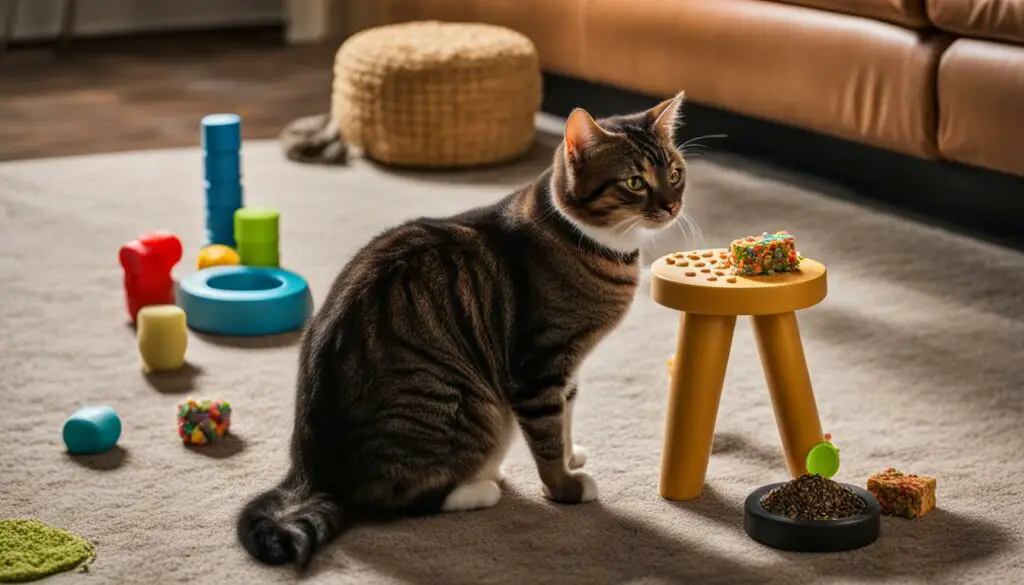
Troubleshooting Common Issues with Treats
When it comes to training cats, one common challenge is getting them to respond to treats. If your cat is not showing interest or not responding to treats, there are several troubleshooting steps you can take:
1. Evaluate the type of treats:
Not all cats have the same taste preferences. It’s possible that the specific type of treat you are offering may not be appealing to your cat. Consider trying different flavors, textures, or even homemade treats to see if your cat shows more interest.
2. Assess the timing:
The timing of treat distribution can play a big role in your cat’s response. Ensure that you are providing treats immediately after the desired behavior, so your cat can make the connection between the action and the reward. Consistency and prompt reinforcement are key.
3. Check for distractions:
If your cat is easily distracted during training sessions, it may be difficult for them to focus on the treats. Find a quiet, calm environment where your cat can fully concentrate on the training process. Minimize any potential distractions, such as other pets or loud noises.
4. Consider potential health issues:
If your cat consistently shows no interest in treats, it’s possible that there may be an underlying health issue affecting their appetite or motivation. Take your cat for a check-up with a veterinarian to rule out any medical conditions that may be contributing to their lack of response.
| Issue | Troubleshooting Steps |
|---|---|
| Cat not showing interest in treats | Try different flavors or textures, provide treats immediately after desired behavior, eliminate distractions during training sessions, check for underlying health issues |
| Cat refusing treats altogether | Experiment with different types of treats, ensure freshness and quality of treats, try using alternative rewards such as toys or praise |
| Cat turning away from treats | Assess timing of treat distribution, find a quiet and calm training environment, consider the size and texture of treats |
Remember, every cat is unique, and what works for one may not work for another. It’s important to be patient and persistent in your training efforts. If you are still having difficulty getting your cat to respond to treats, consulting with a professional cat trainer or behaviorist may provide additional insights and guidance.
The Role of Variety in Cat Treats
When it comes to treating your cat, variety is key. Just like humans, cats can quickly become bored with the same old treats day after day. By offering a variety of flavors, textures, and smells, you can keep your cat engaged and interested in their treats. Plus, introducing new treats can be a fun and exciting experience for both you and your furry friend.
Rotating different types of treats also helps prevent your cat from becoming too reliant on one specific type. This is especially important if you are using treats as a training tool. By mixing things up, you can ensure that your cat remains motivated and eager to earn their rewards.
The Benefits of Variety in Treats
There are several benefits to incorporating variety into your cat’s treat routine:
- Enhanced enjoyment: Offering a variety of treats keeps mealtime exciting for your cat and adds a sense of novelty to their daily routine.
- Improved nutrition: Different treats provide a range of nutrients, helping to diversify your cat’s diet and ensure they are getting a well-rounded nutritional intake.
- Mental stimulation: Introducing new flavors and textures stimulates your cat’s senses and provides mental enrichment, which is important for their overall well-being.
- Bonding opportunities: Sharing new treats with your cat creates opportunities for bonding and strengthens the bond between you and your furry companion.
Remember, variety is important but it’s also essential to choose treats that are nutritionally balanced and suitable for your cat’s specific dietary needs. Consulting with a veterinarian can help guide you in selecting the best options for your cat. So go ahead, embrace variety and watch your cat’s excitement soar as they explore a world of tasty treats!
| Treat Type | Flavors | Texture | Benefits |
|---|---|---|---|
| Crunchy treats | Chicken, fish, turkey | Crunchy | Helps clean teeth and promote dental health |
| Soft treats | Tuna, salmon, cheese | Soft and chewy | Easier to eat, suitable for senior cats or those with dental issues |
| Freeze-dried treats | Beef, liver, chicken | Crunchy and lightweight | Retains nutritional value and flavor |
| Wet food treats | Chicken, seafood, turkey | Moist and tender | Can be used as a meal topper or for cats with dental issues |

Training Techniques for Cats That Don’t Like Treats
If your cat doesn’t respond to traditional treat-based training methods, don’t worry – there are alternative techniques that can be just as effective. While treats are a common incentive for training, not all cats are motivated by food rewards. It’s important to understand your cat’s individual preferences and find alternative training methods that suit their needs.
One alternative technique is clicker training paired with play or attention rewards. Instead of using treats, you can use a clicker to mark desired behaviors and then reward your cat with playtime or affection. This can be especially effective for cats that are more motivated by interactive play or social interaction rather than food.
Another approach is to use shaping behaviors with clicker training, without food rewards. This involves breaking down the desired behavior into small steps and reinforcing each step with a click and praise. Over time, your cat will learn to associate the click with positive reinforcement and will be motivated to perform the desired behavior without the need for treats.
If your cat is not motivated by clicker training, you can incorporate positive reinforcement techniques such as praise, petting, or favorite toys as rewards. By finding what your cat finds rewarding, you can create a positive association with training and encourage desired behaviors.
Remember, every cat is unique, and what works for one cat may not work for another. It may take some trial and error to find the most effective training method for your cat. Be patient, consistent, and adaptable in your approach, and always prioritize your cat’s comfort and well-being in the training process.
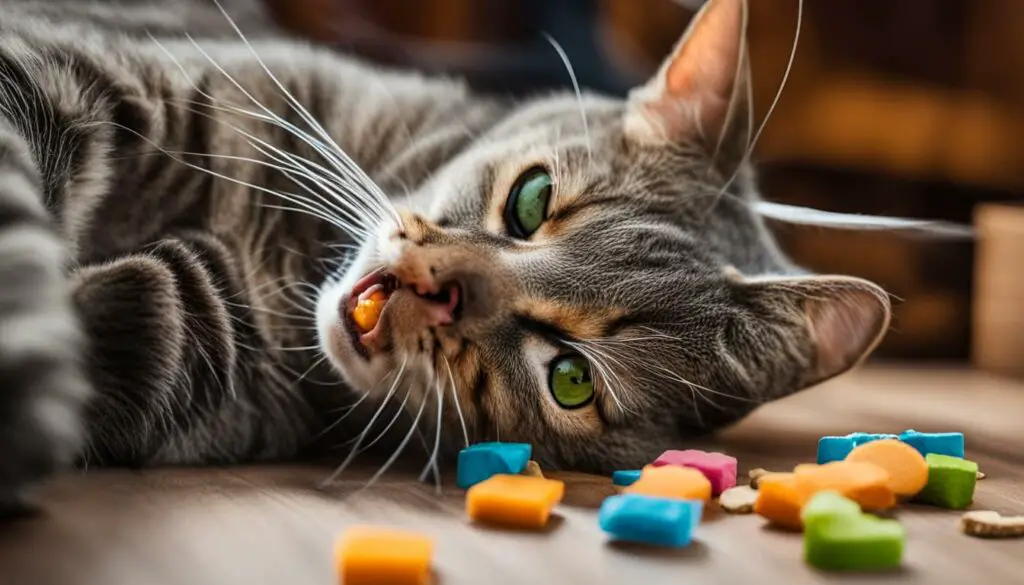
Additional Resources for Training Cats
If you’re looking for further guidance and resources on training cats, there are various options available:
- Consulting a cat behaviorist: A cat behaviorist can provide personalized advice and strategies based on your cat’s specific needs and behavior.
- Professional cat trainers: Seek help from professional cat trainers who specialize in positive reinforcement training techniques.
- Online resources: Many websites offer articles, videos, and tutorials on cat training. Look for reputable sources that provide evidence-based information.
- Books: There are numerous books available on cat training that can provide in-depth knowledge and practical tips.
By utilizing these resources and exploring alternative training techniques, you can effectively train your cat even if they don’t respond to traditional treat-based methods.
Section 12: Monitoring Your Cat’s Overall Health and Appetite
As a responsible cat owner, it’s important to monitor your feline friend’s overall health and appetite. Cats are masters at hiding signs of illness, so it’s crucial to pay close attention to any changes in their behavior or eating habits that could indicate underlying health issues. By staying vigilant and taking proactive measures, you can ensure that your cat stays healthy and receives the necessary care.
One of the key aspects of monitoring your cat’s health is observing their appetite. Changes in eating patterns, such as a sudden loss of interest in food or a significant increase in appetite, can be an indication of an underlying health problem. If your cat consistently refuses treats or shows a lack of appetite, it’s essential to consult with a veterinarian to rule out any medical conditions.
In addition to monitoring their appetite, it’s important to watch for other signs of health issues in cats. This includes changes in litter box habits, weight loss, excessive thirst, vomiting, diarrhea, coughing, sneezing, or any unusual behavior. These could be symptoms of various health conditions, including dental problems, gastrointestinal issues, kidney disease, diabetes, or respiratory infections.
Regular veterinary check-ups are also crucial for maintaining your cat’s overall health. These visits allow the veterinarian to perform a thorough examination, address any concerns or questions you may have, provide necessary vaccinations, and detect any potential health issues early on. Remember, prevention is always better than cure when it comes to your beloved feline companion.
| Signs of Health Issues in Cats | What to Look For |
|---|---|
| Changes in appetite | Sudden loss or increase in appetite |
| Changes in litter box habits | Urinating or defecating outside the litter box |
| Weight loss | Noticeable decrease in body weight |
| Excessive thirst | Increased water consumption |
| Vomiting or diarrhea | Recurring episodes of vomiting or loose stools |
| Coughing or sneezing | Persistent coughing or sneezing |
| Unusual behavior | Changes in activity level or social interaction |
By closely monitoring your cat’s overall health and appetite, you can detect any potential issues early on and take appropriate action. Remember to consult with your veterinarian if you notice any concerning changes in your cat’s behavior or eating habits. With proper care and attention, you can help your furry friend live a long, healthy, and happy life.
Seeking Professional Guidance
If you’re struggling to train a cat that doesn’t like treats, it may be beneficial to seek professional help. Consulting with a cat behaviorist or professional cat trainer can provide you with personalized advice and strategies tailored to your specific cat’s needs. These experts have extensive knowledge and experience in understanding cat behavior, and they can offer valuable insights and support to help you overcome training challenges.
A cat behaviorist will assess your cat’s behavior, identify any underlying issues, and develop a customized training plan to address them. They can help you understand your cat’s motivations, preferences, and unique personality, allowing you to modify your training techniques accordingly. Additionally, they can provide guidance on how to create a positive and engaging training environment that fosters your cat’s learning and development.
Professional cat trainers can also offer valuable assistance and guidance. They have expertise in using positive reinforcement techniques, shaping behaviors, and addressing training challenges. They can teach you effective strategies for using rewards other than treats, such as toys, playtime, and attention, to motivate and reinforce good behavior in your cat.
There are many cat training resources available online, including websites, books, and courses, that can provide additional guidance and tips. These resources can be especially helpful if you prefer to take a DIY approach to training your cat or if you want to enhance your understanding of cat behavior and training techniques.
| Professional Help for Cat Training | Consulting a Cat Behaviorist | Cat Training Resources |
|---|---|---|
| Cat behaviorists and professional cat trainers can provide personalized advice and strategies for training your specific cat. | A cat behaviorist will assess your cat’s behavior, identify underlying issues, and develop a customized training plan. | Online resources, books, and courses can provide guidance and tips for training cats. |
| They have expertise in understanding cat behavior and can offer valuable insights and support. | They can help you understand your cat’s motivations, preferences, and unique personality. | These resources can be especially helpful if you prefer a DIY approach or want to enhance your understanding of cat behavior. |
| They can teach you effective strategies for using rewards other than treats to motivate and reinforce good behavior. | They can assist in creating a positive and engaging training environment for your cat. | – |
Conclusion
In summary, if your cat doesn’t like treats, there are several factors to consider and solutions to explore. It’s important to understand that cats have individual preferences and motivations, and what works for one cat may not work for another. By addressing potential issues such as overfeeding, treat appeal, and negative associations, you can increase your cat’s food motivation and interest in treats.
If your cat is picky with treats, it’s essential to find out what types of treats they prefer and adjust accordingly. Additionally, if your cat is showing signs of lethargy or disinterest in food overall, it’s crucial to consult a veterinarian to rule out any underlying health issues.
There are alternative rewards to explore if your cat doesn’t respond to treats, such as toys or catnip. It’s also important to incorporate treats effectively into training by choosing the right type of treat, using proper reinforcement techniques, and being consistent.
Overall, patience, adaptability, and prioritizing your cat’s health and well-being are key in training a cat that doesn’t like treats. Seeking professional guidance can provide valuable insights and support in navigating this process. With time and effort, you can establish a rewarding and enjoyable training experience with your feline companion.
FAQ
Why is my cat picky with treats?
Cats can be selective with treats for various reasons, including already being full from eating regular meals, not liking the specific type of treat being offered, or having individual preferences.
How can I increase my cat’s food motivation?
To boost your cat’s appetite for treats, you can switch from free-feeding to scheduled meals, offer a wet or raw diet, and avoid creating negative associations with treats.
How do I choose the right treats for my cat?
It’s important to consider your cat’s preferences and dietary needs when choosing treats. Experiment with different types of treats, read ingredient labels, and consult with a veterinarian for guidance.
What are some tips for training a cat that’s not food motivated?
Breaking treats into smaller pieces, using toys or catnip as rewards, finding alternative rewards, and seeking advice from professionals can help train a cat that’s not food motivated.
How can I control my cat’s treat intake?
It’s crucial to monitor your cat’s treat consumption and ensure they are not overfed. Treats should make up no more than 5% of their daily caloric intake.
What can I use as rewards instead of treats?
Toys and catnip can be great alternatives to treats as rewards. Find what motivates your cat and use it to reinforce positive behavior.
How can I incorporate treats into training?
Treats can be used as rewards during training sessions to reinforce positive behavior. Timing and proper reinforcement techniques are key.
What should I do if my cat doesn’t respond to treats?
If your cat consistently refuses treats or shows a lack of interest, it’s important to consider underlying factors such as health issues. Adjusting treat types or training methods may be necessary.
Why is variety important in cat treats?
Offering variety in cat treats can keep your cat engaged and prevent boredom. Rotating different types of treats can also prevent reliance on a specific treat.
Are there training techniques for cats that don’t like treats?
Yes, there are alternative techniques such as clicker training paired with play or attention rewards, shaping behaviors without food rewards, and incorporating positive reinforcement techniques.
How can I monitor my cat’s overall health and appetite?
Changes in eating patterns or behavior can be signs of underlying health issues. Regular check-ups and appropriate nutrition are important for maintaining your cat’s well-being.
Should I seek professional guidance for cat training?
If you’re struggling with training or have specific issues, consulting a cat behaviorist or professional cat trainer can provide personalized advice and support. Online resources and books are also available.

